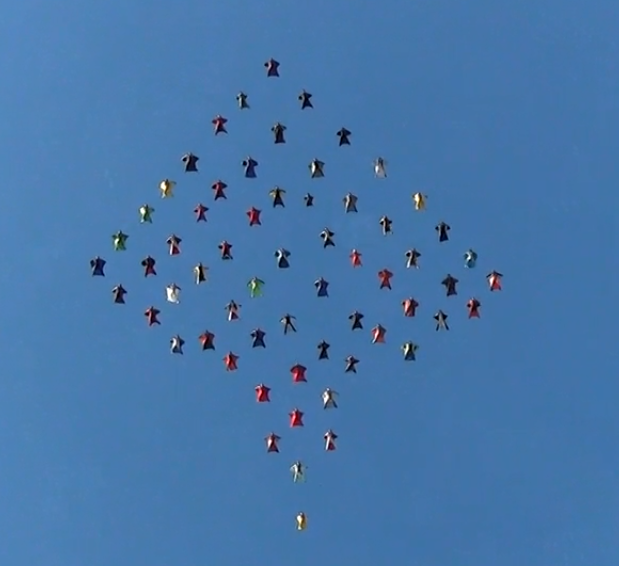Recommended Posts
mdrejhon 8
Although I am familiar with just staying in full glide (or even using double fronts) for better penetration in a strong head wind... As well as loosening chest strap to flatten the glide and lifting my legs for a terrible spot... (Reference: Brian Germain's Parachuting and its Pilot)QuoteBut in neutral, cross and/or headwind conditions, there is a good chance you'll do better on your rears.
I thought that for BOTH stationary and tail wind situations, that the same technique (toggle or rears) would come out ahead the same way. i.e. if toggles performs better than rears with a tailwind (as it seems to do on my Sabre 170), it does so regardless whether it's a tailwind or neutral?
Can anyone explain why there may be a situation where toggles may perform better during tailwind and rears may perform better during no-wind situations? (or vice-versa) Can someone explain to me a specific situation where this may be possible -- I mean, it mathematically doesn't make sense to my less-experienced brain, so I need an example.
kallend 2,114
QuoteAlthough I am familiar with just staying in full glide (or even using double fronts) for better penetration in a strong head wind... As well as loosening chest strap to flatten the glide and lifting my legs for a terrible spot... (Reference: Brian Germain's Parachuting and its Pilot)QuoteBut in neutral, cross and/or headwind conditions, there is a good chance you'll do better on your rears.
I thought that for BOTH stationary and tail wind situations, that the same technique (toggle or rears) would come out ahead the same way. i.e. if toggles performs better than rears with a tailwind (as it seems to do on my Sabre 170), it does so regardless whether it's a tailwind or neutral?
Can anyone explain why there may be a situation where toggles may perform better during tailwind and rears may perform better during no-wind situations? (or vice-versa) Can someone explain to me a specific situation where this may be possible -- I mean, it mathematically doesn't make sense to my less-experienced brain, so I need an example.
Although this is for gliders, it may help. AT least it shows what a "polar" is. home.att.net/~jdburch/polar.htm
Basically the best glide speed ( for a glider or a canopy) is the speed at the point of contact of a tangent to a curve called the "polar" of the airfoil. Changing the wind moves the origin of the tangent line, and different airfoil polars (brakes or risers) may produce better performance when the origin of the line is in different places. So what's best for no-wind may not be best for a tailwind.
The only sure way to survive a canopy collision is not to have one.
kallend 2,114
QuoteLet's say that you ended up with a long spot.
Assuming that you could hold the rear risers for that length of time, would you get more horizontal distance from the rear risers or deep brakes, and why?
My Stiletto seems better in brakes, and my Spectre seems better in rear risers.
The only sure way to survive a canopy collision is not to have one.
jheadley 0
Quote
I thought that for BOTH stationary and tail wind situations, that the same technique (toggle or rears) would come out ahead the same way. i.e. if toggles performs better than rears with a tailwind (as it seems to do on my Sabre 170), it does so regardless whether it's a tailwind or neutral?
Can anyone explain why there may be a situation where toggles may perform better during tailwind and rears may perform better during no-wind situations? (or vice-versa) Can someone explain to me a specific situation where this may be possible -- I mean, it mathematically doesn't make sense to my less-experienced brain, so I need an example.
Read page 56 of The parachute and it's pilot, and the Downwind Glide diagram. Brakes and rear risers both flatten the true glide of the parachute, but if you've got a strong tailwind, what you want is minimum sink, not maximum glide. In deep brakes, the idea is to lose as little altitude as possible, and have the wind carry you back, giving you a very high relative glide.
For a specific example, lets say you are on a long spot on a light to no wind day. Rear risers would probably benefit you the best, because they would flatten your true glide while keeping the drag and forward speed almost the same, although this does depend on the canopy.
Now lets say you're on a long spot, and the winds at 3000 feet are blowing at 30mph. You are upwind of the dropzone, so when you fly towards the dropzone, the wind is at your back. By going into 99% brakes and trying to slow your vertical descent speed as much as you can, you just float in the sky, and let the strong wind push you back to the dropzone like you're a hot-air balloon.
This is how I understand it anyway. I hope this is right.
billvon 3,085
Depends on about a dozen factors, including wind, type of canopy, loading etc.
But some general suggestions:
If you're backing up, heavy front riser is going to be your best bet. It will increase your forward speed a bit, but more importantly get you on the ground faster.
If you're far upwind and have to cover a lot of distance, minimum descent rate is what you should be aiming for, so the wind has more of a chance to carry you a long distance. Toggles generally work better than risers for this.
In still air:
0) Kill your slider and pull it down over the links. Reduces drag; helps spread out the canopy.
1) Loosen your chest strap. Allows the risers to spread out.
2) Instead of pulling the rear risers down, spread them. This will pull the center of the canopy down a bit and flatten the rest of it, making it slightly more efficient.
3) If you do use toggles, try using small amounts only. You just want a slight increase in lift; you don't want to sink.
Pulse 0
But in a headwind slowing the parachute down WILL limit your forward movement. Unless you're very sparing on the controls. If I'm making any forward progress into the wind I might add a touch of rear-risers or brakes to see if I can do any better.
This brings me to my main point. We focus a lot on half-brakes, quarter-brakes, rear-risers, etc. Learn the 'accuracy trick' and pay attention to it. It's really that simple. Many times in deep brakes you will have your doubts because it doesn't feel like you're going anywhere. Looking down won't tell you much, look for that spot ahead of you that gets bigger and closer.
kallend 2,114
billvon 3,085
> get one's best glide out of their canopy.
Because glide angle with respect to the ground is not the same as glide angle with respect to the air. In an extreme case (tailwind of 40kts) staying aloft longer will absolutely get you more distance - and thus deep brakes is the best bet. In another extreme case (headwind of 40kts) front risers will get you down fastest and prevent too much backing up.
In between those extremes are two general cases. In no winds or light headwinds, generally full flight is your best bet. With a tailwind, generally some brake is the best bet.
d123 3
QuoteQuoteI'm not sure I'm following how wind changes the technique used to get one's best glide out of their canopy. .
Take a look at THIS.
Great article. One thing is worth mention:
Those graphs makes sense only if you decrease the airspeed with the stick input (AoA/chamber modification). If you decrease the air speed with the spoilers the GR will always decrease with the decrease in airspeed.
I've made one introductory flight and I plan to continue when the season starts again. One thing that didn't make any sense to me was the string placed on the canopy. People told me that is used to indicate the cross wind. I've found it funny because I've thought that the direction of the relative wind is always constant.
ryoder 1,590
Quote
I've made one introductory flight and I plan to continue when the season starts again. One thing that didn't make any sense to me was the string placed on the canopy. People told me that is used to indicate the cross wind. I've found it funny because I've thought that the direction of the relative wind is always constant.
The purpose of the string is to show you whether you are using too much rudder, or not enough.
Pulse 0
QuoteOne thing that didn't make any sense to me was the string placed on the canopy. People told me that is used to indicate the cross wind. I've found it funny because I've thought that the direction of the relative wind is always constant.
It is, the string shows slip angle
Pulse 0
QuoteQuoteI'm not sure I'm following how wind changes the technique used to get one's best glide out of their canopy. .
Take a look at THIS.
Yes, I read this when it was posted earlier. I'm not finding much of an application for it though. Pay attention to the 'spot' on the ground that shows your glide. Do this, experiment, and you've got it made.
denete 3
QuoteI've made one introductory flight and I plan to continue when the season starts again. One thing that didn't make any sense to me was the string placed on the canopy. People told me that is used to indicate the cross wind. I've found it funny because I've thought that the direction of the relative wind is always constant.
Not with a vehicle that moves faster than the air around it...and that has the ability to turn.
"our attitude is the thing most capable of keeping us safe"
(look, grab, look, grab, peel, punch, punch, arch)
kallend 2,114
QuoteQuoteQuoteI'm not sure I'm following how wind changes the technique used to get one's best glide out of their canopy. .
Take a look at THIS.
Yes, I read this when it was posted earlier. I'm not finding much of an application for it though. Pay attention to the 'spot' on the ground that shows your glide. Do this, experiment, and you've got it made.
It doesn't for a given wind condition, but as the wind changes so the best technique may well change.
The only sure way to survive a canopy collision is not to have one.
relyon 0
Quote... the string shows slip angle
On a helicopter the string has additional uses beyond those listed here (eg. dropping below ETL). A very simple and useful instrument - IIRC the U-2 had one.
Bob
jsaxton 0
Croc 0
Charles Fort, commenting on the many contradictions of astronomy



.thumb.jpg.4bb795e2eaf21b8b300039a5e1ec7f92.jpg)




Deep brakes should get you more float (lower descent rate) than risers, which is good for running with med to strong wind. In lighter winds, just keep practising what Dave said about judgement.
If what you were asking was which profile gives the best glide angle in still air I _think_ that would vary with each canopy, and rarely be directly applicable to an actual jump. I am most definitely open to correction on that though.
Share this post
Link to post
Share on other sites